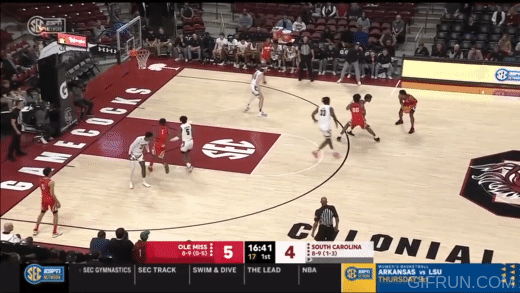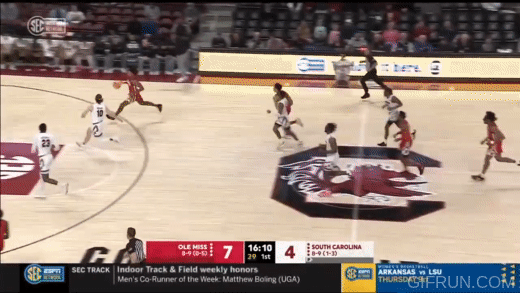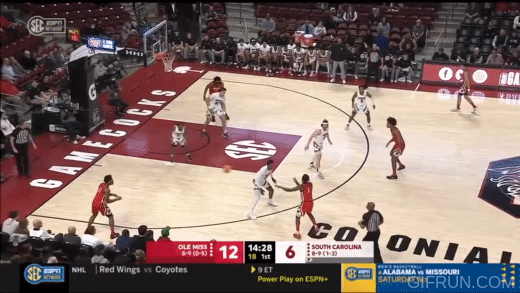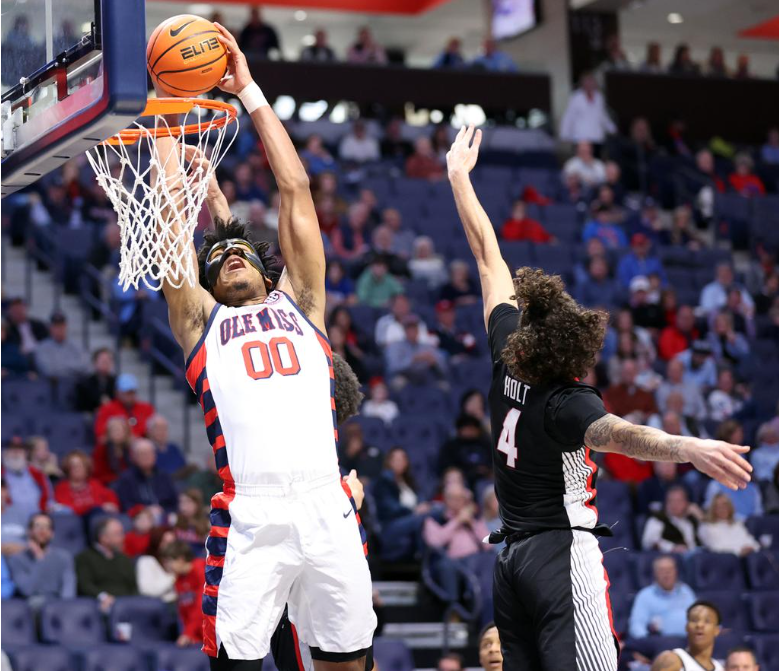Sitting at 1-5 in the SEC, the Hogs are now in desperation mode to save their season. The best friend of a struggling team is another struggling team, and fellow 1-and-5er Ole Miss visits Fayetteville on Saturday.
Meet the Rebels
Despite only one NCAA Tournament appearance and zero finishes higher than 6th in the SEC, the Rebels retained coach Kermit Davis this offseason even after rival Mississippi State dumped Ben Howland, who had a slightly better record. Ole Miss went just 13-19 (4-14 SEC) last year, but the Rebels had a lot of injury issues, and Ole Miss honestly seems too invested in football and baseball right now to deal with the headache of a coaching search for a program with a very low ceiling in basketball.
So Davis is back for a fifth season, and it’s going about as expected. With a healthy roster to start the year, most picked the Rebels to improve slightly from last year but still be in the bottom half of the conference standings. So far, that’s holding true.

The Rebels finally snapped a six-game losing streak this week with a road win over South Carolina. But they are still just 1-5 in SEC play with non-conference losses to Oklahoma, Memphis, UCF, and North Alabama. Their best win is that 80-67 drubbing of Florida Atlantic: that’s the Owls’ only loss, as they are 18-1 with a win over Florida.

Both teams are headed in the wrong direction: out of 363 teams, Arkansas ranks 362nd in Momentum, while Ole Miss is at 320th. Somebody is going to manage to turn things around on Saturday.
Model pick: Arkansas 75, Ole Miss 64.
Scouting Report
The Ole Miss offense is all about rim-running. The Rebels have several athletic wings and small forwards who are very good at crashing the offensive boards. They take a high share of shots around the rim. Like Arkansas, they are a very poor jump-shooting team, so rebounding is the key to stopping their offense. They struggle with turnovers and don’t do a great job of getting to the line.
Defensively, the Rebels play a tough man-to-man scheme that smothers the perimeter and defends inside the arc, all without fouling. They struggle to create turnovers. Offensive rebounds could be a major issue for them if they choose to go zone against the Hogs.
Starters
Ole Miss
- Matthew Murrell, PG, 6’4 (+4.2 BPM, 52 RAPM)
- Amaree Abrham, PG, 6’4 (-0.9 BPM, 65 RAPM)
- Myles Burns, SF, 6’6 (+4.3 BPM, 77 RAPM)
- Jayveous McKinnis, PF, 6’7 (+4.1 BPM, 51 RAPM)
- Jaemyn Brakefield, PF, 6’8 (+3.4 BPM, 63 RAPM)
Arkansas
- Anthony Black, PG, 6’7 (+4.1 BPM, 100 RAPM)
- Ricky Council IV, PG, 6’6 (+5.1 BPM, 98 RAPM)
- Devo Davis, SG, 6’4 (+0.2 BPM, 96 RAPM)
- Jordan Walsh, SF, 6’7 (+2.7 BPM, 100 RAPM)
- Makhi Mitchell, PF, 6’9 (+7.1 BPM, 76 RAPM)
Black will have a 3-inch height advantage, but otherwise, these two teams are roughly equal in size.
The key for Ole Miss is Murrell, who leads the team in minutes and usage (25%). He’ll take about half his shots from beyond the arc, but he’s a poor shooter from out there (just 30%). He can also put it on the deck and draw a foul around the hoop, but he isn’t a particularly strong finisher.
Ole Miss will play small-ball and you’ll mostly 4- and 5-out motion. They run some really good sets. Murrell is always looking to attack off a high pick-and-roll with their big:

The other high-use guy is Murrell’s backcourt mate, Abram, who reminds me a lot of Devo. He leads the team in assist rate (16%) and also grades as the team’s best defender (98 DRAPM) thanks to his perimeter-smothering skills. He’s a capable 3-point shooter (35%) but he’s less of a threat around the rim. He is prone to reckless drives and passes, so his turnover rate (24%) is way too high.
The main guy that will occupy the post is McKinnis. He’s extremely low-usage (just 12%), but he shoots a high percentage around the rim (64% EFG) and is a good offensive rebounder (10%). He also doesn’t turn it over much at all (12%). You’ll see him on pick-and-rolls with Murrell and he’ll often flash into the post to take a dump-off pass from a driving guard. He does not grade as a very good defender.
A bench player to watch in the post is 6’11 center Theo Akwuba. He doesn’t play much, largely because he adds nothing to the offense due to his very high turnover rate (27%), but he leads the team in shot block rate (7%, higher than any Hog) and grades at a solid 82 DRAPM, third-best on the team. If the Rebels are getting beat around the rim, they could try out Akwuba for a spell.
Finally, you have the wings: Brakefield, Burns, and reserve Robert Allen, a 6’8 senior. Brakefield is a pretty good shooter who can step outside and knock down a 3 or get to the rim and draw contact. He also takes care of the basketball and is a good passer on the perimeter. He’s easily the best offensive threat outside of Murrell.
Burns and Allen are your main rim-runners. They’re tied for the team lead with an 11% offensive rebound rate. Burns is really struggling to shoot (he’s 3 of 31 from beyond the arc… stop shooting dude!) but his fantastic rebounding rate (team-best 15%) and excellent defense (93 DRAPM, second-best) help him grade as one of Ole Miss’s best players, or at least most valuable. Allen, on the other hand, is worst on the team in RAPM. He’s also struggling to shoot (just 43% EFG), but he also has an incredibly-high turnover rate (26%) and while he’s good at offensive rebounding, he’s a poor defensive rebounder for his size (13%).
When Ole Miss has the ball

Ole Miss’s offense is its weak point. When forced into halfcourt, Ole Miss possessions tend to be long and inefficient. So they’ll try to run. They are pretty good at getting into transition and scoring there. While they are a poor 3-point shooting team, they can find and hit open looks when they’re in transition:

The good passing and spacing that is characteristic of Kermit Davis teams helps them more when they are in transition.
In halfcourt, they’ll still get great movement and spacing:

This sequence is really instructive, as you can see several things: good spacing, aggressive drives to the rim, lots of patience. In this case, they actually do get a decent look (McKinnis got fouled here). That does not always happen. But that’s what they want to do.

They are a very bad jump shooting team, so they’re going to try to get to the rim. They will even pass up semi-open shots on the perimeter. Expect Arkansas to intentionally leave bad shooters open on the outside; that’s a classic Musselman move. If they can get near the rim, they can create offensive rebounds, which are key to their offense working.
They are turnover-prone. Arkansas has lost the turnover battle in all six SEC games so far, but even if Arkansas focuses on clearing the defensive boards (which they probably should), Ole Miss should make enough reckless moves with the ball to help Arkansas finally win a turnover battle.
When Arkansas has the ball

Here we go again: yet another solid halfcourt defense for the Hogs to solve. If the Hogs can run – Ole Miss is vulnerable to transition buckets off turnovers – they can easily score enough points to win. If not, this game will turn into a halfcourt slog and it will be anyone’s game.

Ole Miss’s base defense is very similar to Oklahoma’s: smother the perimeter, force tough two-point shots, clear the defensive rebound, and do it all without fouling. Don’t worry about trying to force turnovers.
On paper, this is a terrible matchup against Arkansas. The Hogs accepted Oklahoma’s gambit and crushed them at the rim. Even decent finishing by the Hogs against this defense would be enough to win easily. So I sort of expect Ole Miss to pepper in some zone, or even go exclusively zone to try and hold on. That will sort of depend on how confident Davis is in his guys, and perhaps how stubborn he is.
Obviously, if the Hogs see zone, the same keys apply: crash the offensive boards, be patient in getting to the rim, and maintain good spacing. Arkansas has looked better against zone over the last few games (compared to the LSU and Auburn games) but there’s still a long way to go.
Keys to the Game
- Finish strong. Arkansas had a mostly-good performance against Mizzou, but they lost a 10-point lead late and just fell short. That’s the second late blown lead of SEC play. Just finishing a game well would do a lot for the team’s confidence.
- Avoid the dumb turnovers. Turnovers really killed the Hogs against Mizzou, and as mentioned, Arkansas is down bad in the turnover battle in SEC play. Arkansas can play good defense without forcing a ton, but it’s tough to play good offense when Black and Devo are combining for 12 giveaways.
- Defend without fouling. Arkansas’ last three games have featured a combined 151 fouls, which is just insane. The officiating in college basketball is really bad, with basic things like hand-checks and blocking fouls not being called consistently. Anticipation fouls are being called at an all-time high. But Arkansas does foul a lot. They can’t control the bad calls, but they can control the correct ones. We’ve talked plenty about Jordan Walsh, and how he is the most valuable player on the offense, but he has to be out there (and thus out of foul trouble) in order to have that impact.
Thanks for reading! Be sure to follow us on Twitter and on Facebook.
The latest from Fayette Villains, straight to your inbox
Enter your email to subscribe and receive new post alerts and other updates. You can unsubscribe at any time.
